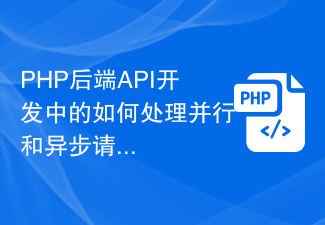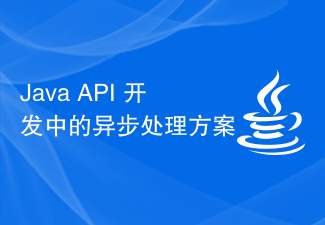 Backend Development
Backend Development PHP Tutorial
PHP Tutorial How to handle parallel and asynchronous requests in PHP backend API development
How to handle parallel and asynchronous requests in PHP backend API developmentWith the continuous development and changes of network applications, handling parallel and asynchronous requests has become an important topic in PHP back-end API development. In traditional PHP applications, requests are performed synchronously, that is, a request will wait until a response is received, which will affect the response speed and performance of the application. However, PHP now has the ability to process parallel and asynchronous requests. These features allow us to better handle a large number of concurrent requests and improve the response speed and performance of the application.
This article will discuss how to handle parallel and asynchronous requests in PHP backend API development. We'll introduce PHP's parallel and asynchronous request handling mechanisms and discuss how to apply them to API development.
What is parallel and asynchronous request processing?
Parallel processing refers to processing multiple requests or tasks at the same time, that is, performing multiple operations at the same time. This is a way to speed up application processing. Parallel processing can be done using multiple threads, multiple processes, or multiple servers, depending on the characteristics of the application and the environment.
Asynchronous processing is an event-driven programming model that does not block during program execution, but continues processing after execution. In PHP, asynchronous processing is usually done using callback functions or coroutines, which makes it easier for applications to implement non-blocking I/O and high concurrent requests.
PHP’s asynchronous request processing
PHP version 5.3 introduces support for asynchronous request processing. PHP uses multiple extensions to implement asynchronous processing, the most commonly used of which are libevent and event. These extensions provide a set of APIs that can be used to create event loops, register callback functions, listen to sockets, and more. PHP's asynchronous request processing mechanism can realize non-blocking I/O, high concurrent requests, long connections, etc.
The following is a sample code using libevent extension:
$base = event_base_new();
$dns_base = evdns_base_new($base, 1);
$event = event_new();
event_set($event, $socket, EV_READ | EV_PERSIST, function($fd, $what, $arg) {
// Processing the socket Word event
});
event_base_set($event, $base);
event_add($event);
event_base_loop($base);
In this example, we use the event_base_new() function to create an event loop, then use the event_new() function to create an event object, and use the event_set() function to register an event handler for the event object. Finally, we start the event loop to listen for socket events through the event_base_loop() function.
Parallel processing of PHP
PHP can use multiple processes or threads when processing parallel requests. PHP's multi-process support is provided by the pcntl extension, while multi-thread support is implemented through the pthreads extension. We will learn about PHP's parallel processing mechanism by introducing these two extensions.
Multi-process processing
Using PHP's pcntl extension, we can run multiple processes at the same time, thereby speeding up application processing. The following is a sample code that uses the pcntl_fork() function to create a child process:
$pid = pcntl_fork();
if ($pid == -1) {
// Failed to create child process
die('Could not fork');
} else if ($pid) {
//The parent process executes the code here
// Wait for the child process to end
pcntl_wait($status);
} else {
// The child process executes the code here
// Processing requests or tasks
exit;
}
In this example, we use the pcntl_fork() function to create a child process, and then in the child process Process the request or task, and finally use the exit() function to end the child process.
Multi-threading
Using PHP's pthreads extension, we can use threads to process requests or tasks. The following is a sample code that uses pthreads extension to create a thread:
class MyThread extends Thread {
public function run() {
// Processing requests or tasks
}
}
$myThread = new MyThread();
$myThread -> start();
$myThread -> ; join();
In this example, we use the pthreads extension to create a thread object, use the start() function to start the thread, and then use the join() function to wait for the thread to end.
Summary
This article introduces parallel and asynchronous request processing technology in PHP back-end API development. Parallel processing in PHP can use multiple processes or threads, while asynchronous processing is usually done using callback functions or coroutines. These technologies can help us better handle a large number of concurrent requests and improve application response speed and performance.
The above is the detailed content of How to handle parallel and asynchronous requests in PHP backend API development. For more information, please follow other related articles on the PHP Chinese website!
 PHP后端API开发中的如何处理并行和异步请求Jun 17, 2023 pm 04:22 PM
PHP后端API开发中的如何处理并行和异步请求Jun 17, 2023 pm 04:22 PM随着网络应用的不断发展和变化,处理并行和异步请求已经成为PHP后端API开发中的一个重要主题。在传统的PHP应用中,请求是同步进行的,即一个请求在收到响应之前会一直等待,这会影响应用的响应速度和性能。但是,PHP现在已经拥有了并行和异步请求处理的能力,这些功能让我们可以更好地处理大量并发请求,提高应用的响应速度和性能。本文将讨论PHP后端API开发中的如何处
 Java API 开发中的异步处理方案Jun 18, 2023 am 10:11 AM
Java API 开发中的异步处理方案Jun 18, 2023 am 10:11 AM随着Java技术的不断发展,JavaAPI已经成为许多企业开发的主流方案之一。在JavaAPI开发过程中,常常需要对大量的请求和数据进行处理,但是传统的同步处理方式无法满足高并发、高吞吐量的需求。因此,异步处理成为了JavaAPI开发中的重要解决方案之一。本文将介绍JavaAPI开发中常用的异步处理方案及其使用方法。一、Java异
 解决Vue异步请求数据实时更新问题Jun 30, 2023 pm 02:31 PM
解决Vue异步请求数据实时更新问题Jun 30, 2023 pm 02:31 PMVue开发中如何解决异步请求数据的实时更新问题随着前端技术的发展,越来越多的网页应用都采用了异步请求数据的方式,以提高用户体验和页面性能。而在Vue开发中,如何解决异步请求数据的实时更新问题是一个关键的挑战。实时更新是指当异步请求的数据发生变化时,页面能够自动更新以展示最新的数据。在Vue中,有多种解决方案可以实现异步数据的实时更新。一、使用Vue的响应式机
 PHP后端API开发中的性能调优技巧Jun 17, 2023 am 09:16 AM
PHP后端API开发中的性能调优技巧Jun 17, 2023 am 09:16 AM随着互联网的快速发展,越来越多的应用程序采用了Web架构,而PHP作为一种广泛应用于Web开发中的脚本语言,也日益受到了广泛的关注与应用。随着业务的不断发展与扩展,PHPWeb应用程序的性能问题也逐渐暴露出来,如何进行性能调优已成为PHPWeb开发人员不得不面临的一项重要挑战。接下来,本文将介绍PHP后端API开发中的性能调优技巧,帮助PHP开发人员更好
 PHP API开发中的最佳跨域策略和实现Jun 17, 2023 am 11:07 AM
PHP API开发中的最佳跨域策略和实现Jun 17, 2023 am 11:07 AMPHPAPI开发中的最佳跨域策略和实现随着RESTfulAPI的兴起,作为后端开发语言的PHP也在众多Web应用中得到了广泛的应用。在开发RESTfulAPI时,往往需要考虑到跨域访问的问题。本文将讨论PHPAPI开发中最佳的跨域策略及如何实现。跨域(Cross-OriginResourceSharing)指的是一个域下的文档或脚本试图去请求另一
 PHP后端API开发中的可扩展性设计Jun 17, 2023 am 11:28 AM
PHP后端API开发中的可扩展性设计Jun 17, 2023 am 11:28 AM随着互联网的快速发展,越来越多的业务需求需要通过网络进行数据交换,其中API作为数据传输的中介,扮演着至关重要的角色。在PHP后端API开发中,可扩展性设计是一个非常重要的方面,它可以使系统拥有更强大的适应能力和延展性,提高系统的健壮性和稳定性。一、什么是可扩展性设计可扩展性是指系统的某项功能可以在不影响系统原有性能的前提下,添加额外的功能以满足业务需求。在
 PHP API开发中的最佳输入和输出验证实践Jun 17, 2023 pm 07:44 PM
PHP API开发中的最佳输入和输出验证实践Jun 17, 2023 pm 07:44 PM在PHPAPI开发中,输入和输出的验证是非常重要并且必不可少的一步。正确认识并严格执行输入和输出验证可以帮助我们减少很多潜在的问题,防范安全漏洞和错误,同时也可以提高应用程序的质量和可靠性。下面是PHPAPI开发中最佳的输入和输出验证实践。输入验证在开发API时,我们应该始终遵循“好的输入才能产生好的输出”的原则。因此,输入验证是非常重要的一部分。以下是
 PHP后端API开发中的安全和防范措施Jun 17, 2023 pm 08:08 PM
PHP后端API开发中的安全和防范措施Jun 17, 2023 pm 08:08 PM在如今的数字化时代,API已经成为了许多网站和应用程序的基石。而PHP这门后端语言也在API开发中扮演者重要的角色。但随着互联网的发展和攻击技术的提高,API的安全问题也越来越受到关注。因此,在PHP后端API开发中,安全和防范措施显得尤为重要。下面,将就此进行探讨:1.安全认证安全认证是API中最基本的保护措施之一。我们通常使用Token或OAuth进行认


Hot AI Tools

Undresser.AI Undress
AI-powered app for creating realistic nude photos

AI Clothes Remover
Online AI tool for removing clothes from photos.

Undress AI Tool
Undress images for free

Clothoff.io
AI clothes remover

AI Hentai Generator
Generate AI Hentai for free.

Hot Article

Hot Tools

mPDF
mPDF is a PHP library that can generate PDF files from UTF-8 encoded HTML. The original author, Ian Back, wrote mPDF to output PDF files "on the fly" from his website and handle different languages. It is slower than original scripts like HTML2FPDF and produces larger files when using Unicode fonts, but supports CSS styles etc. and has a lot of enhancements. Supports almost all languages, including RTL (Arabic and Hebrew) and CJK (Chinese, Japanese and Korean). Supports nested block-level elements (such as P, DIV),

Notepad++7.3.1
Easy-to-use and free code editor

SAP NetWeaver Server Adapter for Eclipse
Integrate Eclipse with SAP NetWeaver application server.

VSCode Windows 64-bit Download
A free and powerful IDE editor launched by Microsoft

DVWA
Damn Vulnerable Web App (DVWA) is a PHP/MySQL web application that is very vulnerable. Its main goals are to be an aid for security professionals to test their skills and tools in a legal environment, to help web developers better understand the process of securing web applications, and to help teachers/students teach/learn in a classroom environment Web application security. The goal of DVWA is to practice some of the most common web vulnerabilities through a simple and straightforward interface, with varying degrees of difficulty. Please note that this software





